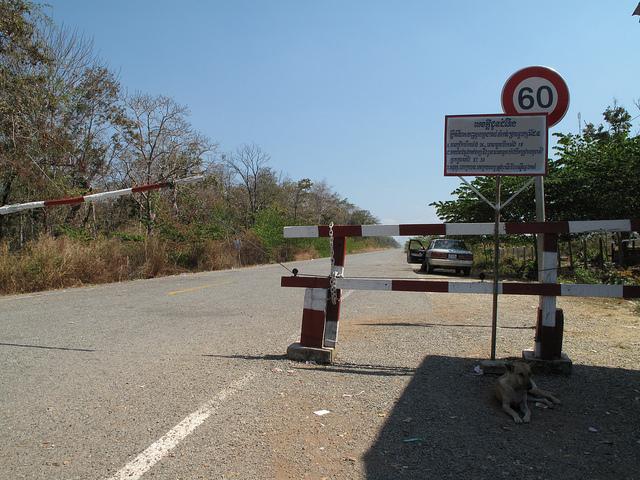ASEAN: securing integrated borders
Posted By John Coyne on October 23, 2017 @ 12:30

The 23rd ASEAN Transport Ministers meeting on 12 October ended on a high note with the signing of an agreement [1] on cross-border transport of passengers by road vehicles. The pact [2] makes it easier to facilitate the entry and transit of passenger busses at ASEAN land borders. It’s a small, yet very important, step forward for ASEAN in its journey towards greater regional economic integration [3] and connectivity [4].
The agreement builds on ASEAN’s other efforts [5] to strengthen air, sea and land links. The master plan on ASEAN connectivity [4] calls for the facilitation of seamless passenger traffic and reduced transport costs in the region to further promote and develop tourism, investment, trade and cultural exchange.
Unfortunately, the region is currently experiencing unprecedented security threats [6] that are unlikely to recede for some time. ASEAN’s security environment is rapidly evolving in terms of irregular migration trends [7], terrorism threats [8] and transnational organised activities [9]. Predictably, these developments are generating increasingly complex border security threats and risks. In the high-stakes games of domestic and national security, day-to-day border security issues can, and do, quickly become extraordinary problems.
Arguably then, ASEAN countries will need to do much more—especially in relation to border security—before further meaningful economic integration can be achieved.
Europe’s experiences with economic integration provide plenty of border security lessons for ASEAN [10]. Europe’s Schengen zone [11] was developed to promote ‘the free and unrestricted movement of people, goods, services, and capital [12]’. To make that possible, the Schengen members made border security a collective responsibility, with each member nation maintaining responsibility for its domestic and national security. In practice, European border security consists of hard security measures at Europe’s external sea, land and air borders; controls between member countries are for the most part non-existent.
Europe’s Schengen countries have always focused more on facilitating the free movement of goods, people and value than on shoring up security. That has created unresolved tension between those responsible for European integration and national security. Arguably, it has also been a catalyst for many of Europe’s border vulnerabilities.
According to the European border management agency, Frontex [13], last year more than 1.8 million illegal border crossings were detected along Europe’s external Schengen borders—six times the number of detections reported in 2014. Europe’s external border security measures are now under immense pressure.
For ASEAN, it’s clear that many national and domestic security risks have a transnational dimension as soon as borders are crossed. The increasingly transnational nature of terrorism and organised crime means that the nexus between domestic and national security issues is no longer as clear as it once was. In this landscape, governments must strive unilaterally or multilaterally to improve interinstitutional communication and interservices cooperation before, at and after the border.
The European experience reinforces the perspective that border agencies need to be able to rapidly deploy capabilities in response to evolving threats, risks or opportunities. It’s this kind of agility that provides options to political leaders dealing with evolving security or economic concerns. Enhancing the agility of ASEAN’s disparate border agencies won’t be an easy, or short-term, task.
Supply-chain security will also be critical to the success of ASEAN’s border integration strategy. At a regional level, the accreditation and ongoing management of supply-chain participants will be fundamental to integration. The physical security of people and goods within those supply chains will be of equal importance.
To move regional economic integration forward, ASEAN countries will need to consider developing minimum border and supply-chain security requirements. Those minimum standards ought to include reference to the requirements of the United Nations Convention against Corruption [14] (UNCAC).
UNCAC provides both a strong foundation and a clear road map for ASEAN’s response to corruption in supply chains. ASEAN countries have made substantive, albeit uneven, progress towards UNCAC’s implementation [15]. The challenge for ASEAN now is to continue to accelerate that change in momentum so that it keeps pace with the drive for further border integration.
ASEAN will need much more than static security standards if it is to maintain regional, national and domestic security. It will need to be especially mindful of the social, geopolitical and economic factors that affect migration flows and border security in order to employ early intervention strategies.
The proper management of external borders ought to be predicated on achieving harmony between security functions and border facilitation. The harmonisation effort should be a continuous activity guided by the economic and security context. But make no mistake—harmonising borders across an economically integrated ASEAN is going to be an arduous and complex endeavour.
Article printed from The Strategist: https://aspistrategist.ru
URL to article: /asean-securing-integrated-borders/
URLs in this post:
[1] an agreement: http://asean.org/joint-ministerial-statement-of-the-twenty-third-asean-transport-ministers/
[2] pact: http://www.businesstimes.com.sg/government-economy/asean-steps-up-efforts-on-seamless-sea-and-sky
[3] integration: http://asean.org/storage/2017/06/AEIB_No.01-June-2017_rev.pdf
[4] connectivity: http://www.asean.org/storage/images/ASEAN_RTK_2014/4_Master_Plan_on_ASEAN_Connectivity.pdf
[5] other efforts: http://asean.org/storage/2012/05/Consolidated-Strategic-Action-Plan-endorsed-060217rev.pdf
[6] unprecedented security threats: http://asean.org/?static_post=asean-regional-security-the-threats-facing-it-and-the-way-forward-by-asean-secretariat
[7] irregular migration trends: https://thediplomat.com/2015/09/adrift-in-asean-tackling-southeast-asias-migration-challenge/
[8] terrorism threats: https://www.aspistrategist.ru/report/counterterrorism-yearbook-2017
[9] transnational organised activities: http://theconversation.com/asia-is-in-the-grip-of-a-transnational-crime-crisis-but-governments-look-away-69780
[10] lessons for ASEAN: https://www.aspistrategist.ru/report/border-security-lessons-australia-europes-schengen-experience
[11] Europe’s Schengen zone: https://www.aspistrategist.ru/report/fractured-europe-schengen-area-and-european-border-security
[12] ‘the free and unrestricted movement of people, goods, services, and capital: http://www.schengenvisainfo.com/schengen-visa-countries-list/
[13] Frontex: http://frontex.europa.eu/news/frontex-publishes-risk-analysis-for-2017-CpJiC8
[14] United Nations Convention against Corruption: https://www.unodc.org/unodc/en/treaties/CAC/
[15] UNCAC’s implementation: https://www.unodc.org/unodc/en/corruption/tools_and_publications/state_of_uncac_implementation.html
Click here to print.